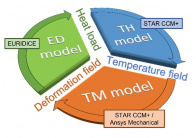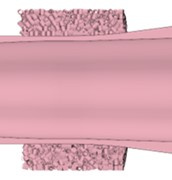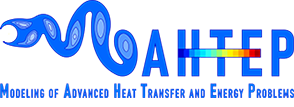Simulation of Gyrotron cavity cooling system equipped with Rashig Rings (RR)
Activity carried out by: Eleonora Gajetti (tutored by Prof. Laura Savoldi)
Objective of the activity: The evaluation and optimization of the current cooling devices for the gyrotron resonant cavities equipped with RR, from hydraulic, thermal and mechanical points of view, to minimize pressure drops, maximize heat removal capability and reduce deformations and stresses.
Framework of the activity:
The assessment of the working conditions of a gyrotron is a complex multi-physics problem, involving electro-dynamic (ED), thermal-hydraulic (TH) and thermo-mechanical (TM) interactions, and it cannot be achieved in a single step simulation. Indeed, the electrodynamic model is necessary to compute the heat losses due to a certain operational point of the cavity, but then it is perturbed by the deformation of the resonator itself because of the heating, whose driver is in turn a certain heat load. Therefore, an iterative process should be performed to accomplish the task, involving the three steps depicted in Figure 1 [1]. The coupling between TM and ED and ED and TH are instantaneously, i.e. the beam-wave interaction and deformation due to thermal load, whilst the temperature field needs few seconds to reach the steady-state. However, as the timescale of Continuous Wave operation of a gyrotron is far larger than this delay in the TH stabilization, the whole process is conducted as stationary.

Figure 1. Graphical representation of the iterative MUCCA tool, with the three steps of the process, their interactions and the used softwares.
The thermal-hydraulic and thermo-mechanical simulations are performed by MAHTEP group using both STAR-CCM+ and Ansys Mechanical, while the electrodynamic ones pertain to the Department of Physics, National and Kapodistrian University of Athens, Greece works, through the use of EURIDICE [2].
To achieve also a complete and comprehensive overview of the life cycle of a gyrotron, a fatigue analysis is performed using Ansys Mechanical, imposing the thermal load calculated during the previous analysis as the alternating load.
The Raschig rings (RR) are millimeter-size, copper hollow cylinders, packed together in the high heat flux region of the cavity cooling system. They are brazed to maintain their position during the fluid flow and to increase their contact area and effective thermal conductivity. Their structure produces an extremely huge heat exchange surface within a small volume, greatly increasing the heat transfer compared to the same circuit without RR. Unfortunately, this setup brings some disadvantages, namely the complete randomness of RR position within the cooling region, which may strongly affect the peak temperature in the cavity, and the enormous complexity of its modelling. Figure 2 shows half of a generic gyrotron cavity with a Raschig rings matrix all around.

Figure 2. Example of a Raschig Rings matrix.
References:
[1] Savoldi, L.; Avramidis, K.A.; Albajar, F.; Alberti, S.; Leggieri, A.; Sanchez, F. A Validation Roadmap of Multi-Physics Simulators of the Resonator of MW-Class CW Gyrotrons for Fusion Applications. Energies 2021, 14, 8027. https://doi.org/10.3390/en14238027
[2] Avramidis, Konstantinos & Pagonakis, Ioannis & Iatrou, C. & Vomvoridis, J. (2012). EURIDICE: A code-package for gyrotron interaction simulations and cavity design. EPJ Web of Conferences. 32. 10.1051/epjconf/20123204016.

